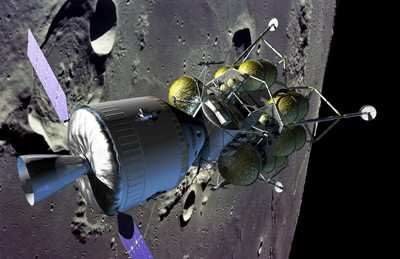Fri, Dec 14, 2007
Successful Test Paves Way For Lunar Ascent Rocket
 Aero-News has learned Alliant
Techsystems recently demonstrated a critical capability of its
liquid oxygen (LOX)/Methane rocket engine, by igniting it in a
vacuum chamber. The successful ignition test was designed to
demonstrate the viability of a LOX/Methane rocket engine for a
lunar ascent mission.
Aero-News has learned Alliant
Techsystems recently demonstrated a critical capability of its
liquid oxygen (LOX)/Methane rocket engine, by igniting it in a
vacuum chamber. The successful ignition test was designed to
demonstrate the viability of a LOX/Methane rocket engine for a
lunar ascent mission.
The test engine was designed for 3,500-lbs-thrust, to bracket
the expected thrust range of a lunar ascent engine. The successful
vacuum chamber test is the latest in a series of tests conducted by
ATK, which calls itself the industry leader in LOX/Methane rocket
engine technology.
The company previously test-fired a 7,500-lbs LOX/Methane engine
at sea-level.
ATK expects to conduct additional tests of its LOX/Methane
engine technology over a wide range of operating conditions to
simulate the environment an operational engine must perform in
during a lunar ascent. The data collected from this test series
will be instrumental in determining performance parameters and the
optimal scale of a flight-weight LOX/Methane engine. The company
will conduct these tests at its test facility in Ronkonkoma,
NY.
The ascent engine is a critical propulsion system on the Lunar
Lander and its operation is required to return the astronauts from
the lunar surface to rendezvous with the orbiting Crew Exploration
Vehicle (CEV).
"Initial tests have already shown performance levels that meet
or exceed engine requirements," according to Bill Rutley, ATK
Senior Program Manager. "We took what we learned on the 7,500 lbs
engine and incorporated design changes into the 3,500 lbs engine to
improve its performance. Based on the latest test data, our vacuum
specific impulse will surpass 350 seconds."

ATK says a LOX/Methane propellant combination offers significant
performance benefits over other propellant combinations. The engine
is also significantly lighter weight and can provide increased
safety margins for the Lunar Lander's design, in terms of allowable
weight of the ascent module.
More News
Airport Marking Aids Markings used on runway and taxiway surfaces to identify a specific runway, a runway threshold, a centerline, a hold line, etc. A runway should be marked in ac>[...]
"It is extremely difficult, if not impossible, for manned aircraft to see a drone while conducting crop-enhancing and other aerial applications at low altitudes and high speeds. We>[...]
Aero Linx: The Skyhawk Association The Skyhawk Association is a non-profit organization founded by former Skyhawk Pilots which is open to anyone with an affinity for the A-4 Skyhaw>[...]
“The T-54A benefits from an active Beechcraft King Air assembly line in Wichita, Kansas, where all required METS avionics and interior modifications are installed on the line>[...]
Aero Linx: Aerostar Owners Association The Association offers the Aerostar Owner a unique opportunity to tap an invaluable source of information concerning the care and feeding of >[...]
 ANN's Daily Aero-Term (04.28.24): Airport Marking Aids
ANN's Daily Aero-Term (04.28.24): Airport Marking Aids Aero-News: Quote of the Day (04.28.24)
Aero-News: Quote of the Day (04.28.24) ANN's Daily Aero-Linx (04.28.24)
ANN's Daily Aero-Linx (04.28.24) Aero-News: Quote of the Day (04.29.24)
Aero-News: Quote of the Day (04.29.24) ANN's Daily Aero-Linx (04.29.24)
ANN's Daily Aero-Linx (04.29.24)




